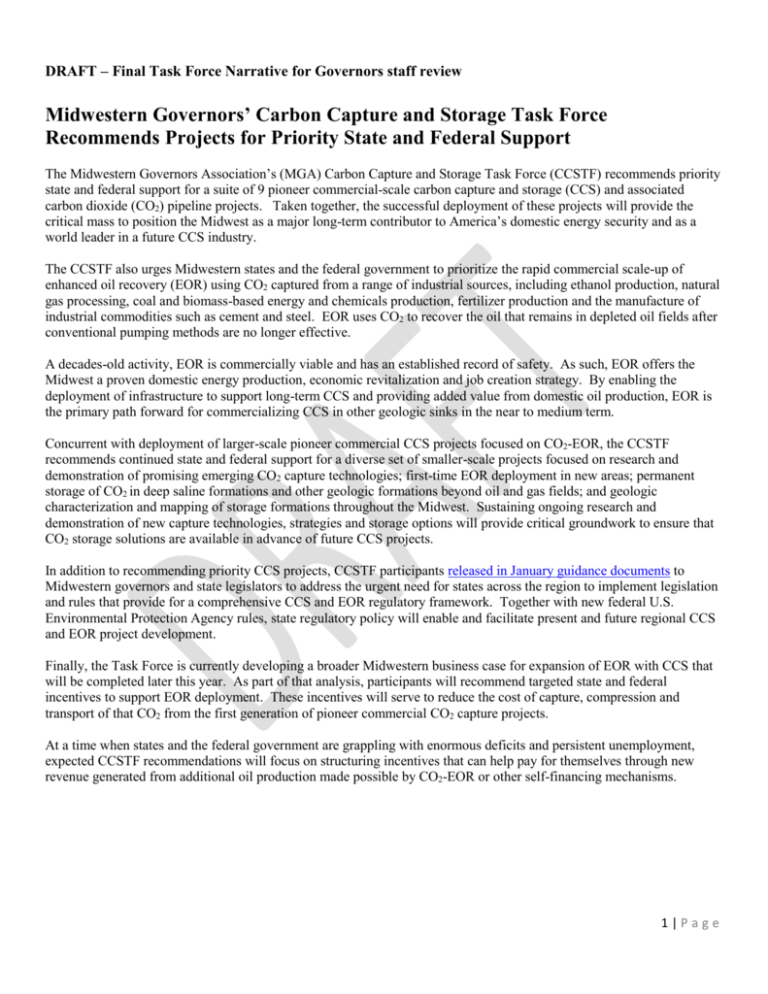CCS Project Narrative - Midwestern Governors Association
advertisement

DRAFT – Final Task Force Narrative for Governors staff review Midwestern Governors’ Carbon Capture and Storage Task Force Recommends Projects for Priority State and Federal Support The Midwestern Governors Association’s (MGA) Carbon Capture and Storage Task Force (CCSTF) recommends priority state and federal support for a suite of 9 pioneer commercial-scale carbon capture and storage (CCS) and associated carbon dioxide (CO2) pipeline projects. Taken together, the successful deployment of these projects will provide the critical mass to position the Midwest as a major long-term contributor to America’s domestic energy security and as a world leader in a future CCS industry. The CCSTF also urges Midwestern states and the federal government to prioritize the rapid commercial scale-up of enhanced oil recovery (EOR) using CO2 captured from a range of industrial sources, including ethanol production, natural gas processing, coal and biomass-based energy and chemicals production, fertilizer production and the manufacture of industrial commodities such as cement and steel. EOR uses CO2 to recover the oil that remains in depleted oil fields after conventional pumping methods are no longer effective. A decades-old activity, EOR is commercially viable and has an established record of safety. As such, EOR offers the Midwest a proven domestic energy production, economic revitalization and job creation strategy. By enabling the deployment of infrastructure to support long-term CCS and providing added value from domestic oil production, EOR is the primary path forward for commercializing CCS in other geologic sinks in the near to medium term. Concurrent with deployment of larger-scale pioneer commercial CCS projects focused on CO2-EOR, the CCSTF recommends continued state and federal support for a diverse set of smaller-scale projects focused on research and demonstration of promising emerging CO2 capture technologies; first-time EOR deployment in new areas; permanent storage of CO2 in deep saline formations and other geologic formations beyond oil and gas fields; and geologic characterization and mapping of storage formations throughout the Midwest. Sustaining ongoing research and demonstration of new capture technologies, strategies and storage options will provide critical groundwork to ensure that CO2 storage solutions are available in advance of future CCS projects. In addition to recommending priority CCS projects, CCSTF participants released in January guidance documents to Midwestern governors and state legislators to address the urgent need for states across the region to implement legislation and rules that provide for a comprehensive CCS and EOR regulatory framework. Together with new federal U.S. Environmental Protection Agency rules, state regulatory policy will enable and facilitate present and future regional CCS and EOR project development. Finally, the Task Force is currently developing a broader Midwestern business case for expansion of EOR with CCS that will be completed later this year. As part of that analysis, participants will recommend targeted state and federal incentives to support EOR deployment. These incentives will serve to reduce the cost of capture, compression and transport of that CO2 from the first generation of pioneer commercial CO2 capture projects. At a time when states and the federal government are grappling with enormous deficits and persistent unemployment, expected CCSTF recommendations will focus on structuring incentives that can help pay for themselves through new revenue generated from additional oil production made possible by CO2-EOR or other self-financing mechanisms. 1|Page Benefits of Midwestern Leadership on CO2-Enhanced Oil Recovery and CCS Through EOR, the Midwest can use CO2 emissions from a range of industrial sources— including ethanol production, natural gas processing, coal and biomass-based energy and chemicals production, fertilizer production and the manufacture of industrial commodities like cement and steel—into a domestic energy security solution that produces more domestic oil, while reducing total CO2 emissions and creating high-paying jobs. Accelerated commercial deployment of EOR is crucial to Midwestern leadership in a future CCS industry. The oil industry can help finance the build-out of a needed CO2 pipeline infrastructure and accelerate the development of a CCS industry to serve Midwestern coal, natural gas, utility, biofuels and other industries for decades to come. Once developed and in place for CO2-EOR, a commercial CCS infrastructure of CO2 capture, compression and pipeline transport can enable long-term storage of industrial CO2 in geologic formations other than oil and gas reservoirs, including deep saline formations. At a time when Midwestern states grapple with the fiscal aftermath of the worst recession since the Great Depression and seek to retool and revitalize the region’s traditional industrial base, CO2-EOR offers a range of important benefits: increase domestic petroleum production from the existing environmental footprint of depleted Midwestern oil fields, without incurring risks associated with new drilling in ever more challenging circumstances; enhance national security by reducing dangerous dependence on oil from unstable and/or hostile regimes; reduce our trade and current account deficits by keeping oil expenditures at home and at work revitalizing America’s heartland; attract private sector investment and new jobs to the Midwest; enable and accelerate commercial deployment of a regional CSS industry to the benefit of many established Midwestern industry sectors; and demonstrate Midwestern leadership in CCS-based carbon reductions in the absence of national agreement on broader federal climate policy. How CO2-EOR Works EOR projects can use CO2 captured and transported by pipeline from industrial sources and then inject that CO2 into depleted oil fields to recover oil that would otherwise be left in place. It is a decades-old commercial activity widely practiced in the Permian Basin of Texas, the U.S. Gulf Coast and elsewhere. Currently, the primary sources of CO2 are natural geologic domes, which are declining in supply, thus operators are looking to secure anthropogenic, or man-made, sources of CO2. Over 50 million tons of CO2 are used every year to force over 250,000 barrels per day of urgently needed domestic crude to the surface. In the Midwest, for example, commercial EOR operations in Michigan, Kansas and North Dakota are using CO2 captured from natural gas processing, ethanol production and lignite coal gasification, respectively. In addition to boosting domestic oil production, large amounts of CO2 injected for EOR can be safely stored in these depleted oil formations. Indeed, EOR using CO2 captured from industrial sources can permanently store more CO2 than is later released by combustion of additional oil recovered in the process. CO2-EOR also uses existing oil and gas infrastructure already in place—with less surface and environmental footprint than the original development activities. National and Regional Oil Production and Carbon Storage Potential of CO2-EOR While traditionally seen as a niche option, recent commercial experience and new estimates of oil production and longterm CO2 storage potential of EOR underscore its important future energy security, economic and carbon mitigation role. According to Advanced Resources International, today’s commercially deployed CO2-EOR technologies and practices have the potential to yield an estimated 38 billion new barrels of economically recoverable oil in the Lower 48 states— nearly twice current U.S. proved reserves—at a substantial net carbon reduction over imported oil displaced (assuming use of CO2 captured from industrial sources). The adoption of next generation EOR technologies and practices could increase technically recoverable oil in the Lower 48 to an estimated 106 billion barrels, or roughly 3.5-5 times U.S. proved reserves. 2|Page Moreover, the Department of Energy’s recent 2010 Carbon Sequestration Atlas estimates 155 billion tons of CO2 storage potential in U.S. and Canadian oil and gas formations, or the equivalent of 37 years’ worth of total U.S. stationary source CO2 emissions (4.1 billion tons annually). While the Midwest is not traditionally considered a major oil producing region, conservative analysis1 commissioned by the MGA concludes that the region has 4.0 to 7.5 billion barrels of oil that could technically be recovered through CO2EOR, substantially boosting U.S. recoverable reserves, as well as Midwestern jobs, investment and state tax revenues. Large-Scale Pioneer Commercial CCS Projects for Priority State and Federal Support In selecting large-scale commercial CCS projects for priority Midwestern state and federal support in the near to medium term, Task Force participants considered a range of criteria, including: capacity to enable CO2 capture and/or geologic storage at commercial scale (million tons or more annually); potential for commercial demonstration of key capture technologies that can be replicated in future projects; availability of state and federal incentives and/or regulatory mechanisms that increase the likelihood of cost recovery and private sector financing; and demonstrated progress toward regulatory approval. The following list is not inclusive of all CCS projects in the Midwest that have merit, nor does it preclude other projects that may emerge or evolve to the point where they deserve priority designation in the future. CCSTF participants may recommend additional projects for priority designation as circumstances warrant. MGSC/Schlumberger Carbon Services/ADM: industrial carbon capture and sequestration (ICCS) project at an ADM ethanol facility. Commercial-scale integrated industrial CCS project; will capture a total of more than 2.5 million tons of CO2 through the life of the project and store it in the Mt. Simon saline formation. American Electric Power (AEP): Mountaineer Plant (New Haven, WV). Expected 90 percent post-combustion capture from 235 Mwe of a 1300 Mwe coal fired power plant using Alstom’s Chilled Ammonia Process (CAP). This will be the first CCS project retrofitted on an existing coal fired unit. In addition, this project will demonstrate largescale integration of post-combustion capture with CO2 storage (injection of 1.5 million tons/year). The Mountaineer project builds on a successful test of Alstom’s CAP technology at We Energy's Pleasant Prairie Power Plant in Southeastern Wisconsin. Erora Group: Cash Creek (Henderson County, KY). A 715 MW (gross) commercial-scale hybrid integrated gasification-combined cycle (IGCC) project with CO2 capture & CO2-EOR. MRCSP-Battelle-Core Energy: Phase III (Otsego County, MI). Battelle and Core Energy are partnering on the Development Phase demonstration of the Midwest Regional Carbon Sequestration Partnership (MRCSP) program with funding from DOE and others. The Phase III demonstration will build upon existing Core Energy commercial CO2-EOR activities and the lessons learned from three smaller-scale injection projects by MRCSP and focus on proving geologic storage potential in the region, evaluating MMV technologies and modeling, protocols and best practices for large-scale projects. Injection of 1 million tons over a four-year period is planned after obtaining an injection permit. Denbury: Midwest to Gulf Coast pipeline. The Denbury pipeline would take CO2 from a set of carbon capture projects in the Midwestern region and transport the CO2 by pipeline to EOR fields in the Gulf Coast region. Two routes are under consideration: the Eastern route connects Indiana and Illinois to Mississippi; the Western route connects Indiana and Illinois to Louisiana. Duke Energy: Edwardsport IGCC Station (Edwardsport, IN). First 618 MW class IGCC for electric generation with partial capture and storage. Plant will begin commercial operation in 2012, with the proposed capture and storage of CO2 as a retrofit dependent on regulatory and economic environment. Ferguson, Robert (June 22, 2009). “CO2-Enhanced Oil Recovery Potential for the MGA Region,” prepared for the MGA by Robert Ferguson, Advanced Resources International. 1 3|Page FutureGen 2.0 (Meredosia, IL and downstream sequestration locations). Repower a 200 MW pulverized coal plant with advanced oxy-combustion technology that is expected to achieve a 90 percent capture rate and eliminate most SOx, NOx, mercury and particulate emissions. Morgan County, Illinois has been selected as the preferred location for the storage site, visitor center, research and training facilities. Illinois Basin – Decatur Project – MGSC/Schlumberger Carbon Services/ADM: Phase III. This project will demonstrate viability of the Mt. Simon saline formation as the predominant storage reservoir in the region, injecting 1 million tons of CO2 into the formation over 3 years. Indiana Gasification/Leucadia (Rockport, IN). Coal to substitute natural gas (SNG) plant using GE technology to produce 40 bcf of SNG; integrated with a CO2-EOR/storage project. Smaller-Scale R&D Projects for Priority State and Federal Support To ensure that robust and comprehensive development of a CCS industry is sustained over the longer-term, the CCSTF recommends continuing partnerships between Midwestern states and U.S. Department of Energy Regional Carbon Sequestration Partnerships, private industry, research institutions and other stakeholders and prioritizing support for the following smaller-scale CCS research and demonstration projects. CCSTF participants believe these projects should be supported in parallel with deployment of the pioneer commercial-scale CO2 capture and pipeline projects described above. Illinois: Evaluation of the Carbon Sequestration Potential of the Cambro-Ordovician Strata of the Illinois and Michigan Basins. The University of Illinois will evaluate the carbon storage potential of the Cambro-Ordovician Strata of the Illinois and Michigan Basins that encompass most of Illinois, Indiana, Kentucky and Michigan. Kansas: Modeling CO2 Sequestration in Saline Formation and Depleted Oil Reservoir to Evaluate Regional CO2 Sequestration Potential of Ozark Plateau Aquifer System, South-Central Kansas. Ohio/Appalachian Basin: East Canton Oil Field (Ohio). This project will determine the viability of this large “Clinton” sandstone oil and gas reservoir for full-scale CO2-assisted EOR and permanent CO2 storage. The initial demonstration project will involve 20,000-50,000 tons of CO2 injection, reservoir characterization and modeling. Success of this pilot could lead to injection of up to 2 million tons of CO2 annually and production of an additional 100 million barrels of oil. Site characterization & geologic mapping. The project will use available data from existing waste injection wells, oil and gas exploration wells and geologic core analyses, focusing on the “Arches Province” geologic formation that underlies parts of Ohio, Indiana, Kentucky and Michigan. Regional characterization project. This Ohio Coal Development Office funded project will assess the geologic storage potential in the upper Ohio River Valley (eastern Ohio and adjacent areas) and develop plans for geologic characterization needed to fully define the sequestration potential along the Ohio Valley energy corridor. Conclusion: Commercial CO2 Capture Projects and Pipelines Needed for EOR Expansion With unstable oil prices, commercially proven technology and know-how readily available, and private capital waiting to invest, the MGA CCSTF aims to address the major remaining barrier to ramping up EOR: the lack of industrial sources of captured CO2 large enough and sufficiently long-term to justify private investment in pipelines and other infrastructure needed to expand EOR to additional fields. Fortunately, the Midwest has North America’s largest cluster of proposed large-scale carbon capture projects nearing commercial operation, as well as a major proposed CO2 pipeline that would transport CO2 from Midwestern industrial sources to Gulf Coast EOR operations. By helping these first generation commercial projects become operational, Midwestern states have the potential to create the critical mass needed to establish a commercial CCS system and industry in the region that would benefit all participating states and a range of industry sectors. 4|Page






